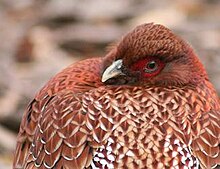Copper pheasant
The copper pheasant (Syrmaticus soemmerringii) is a bird. It is endemic to Japan.
| Copper pheasant | |
|---|---|

| |
| Scientific classification | |
| Domain: | Eukaryota |
| Kingdom: | Animalia |
| Phylum: | Chordata |
| Class: | Aves |
| Order: | Galliformes |
| Family: | Phasianidae |
| Genus: | Syrmaticus |
| Species: | S. soemmerringii
|
| Binomial name | |
| Syrmaticus soemmerringii (Temminck, 1830)
| |
The male measures up to 87.5 to 136 centimetres (34.4 to 53.5 inches) long including the tail. The female measures up to 51 to 54 centimetres (20 to 21 inches). They mainly live in forests and riverbeds in mountainous areas with altitude less than 1,500 metres (4,900 feet).
They are omnivores. They eat plants, leaves, flowers, fruits, seeds, insects, crustaceans etc. They are listed as Near Threatened on the IUCN Red List of Threatened Species.
Copper pheasants lay 6-12 eggs from April to June. The egg has a major diameter of 4.4 to 5.15 centimetres (1.73 to 2.03 inches). It has a minor diameter of 3.3 to 3.65 centimetres (1.30 to 1.44 inches).
Capturing of Masuyamadori was prohibited until September 14, 2017 (Heisei 29).
References
change- ↑ BirdLife International (2016). "Syrmaticus soemmerringii". IUCN Red List of Threatened Species. 2016: e.T22679340A92811551. doi:10.2305/IUCN.UK.2016-3.RLTS.T22679340A92811551.en. Retrieved 12 November 2021.
